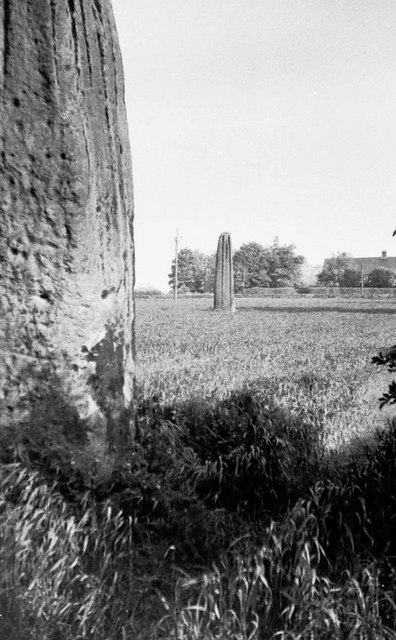Devil's Arrows on:
[Wikipedia]
[Google]
[Amazon]
The Devil's Arrows are four standing stones or

 The name is mentioned by
The name is mentioned by
The Devil's Arrows at Megalithia.com
{{European Standing Stones History of North Yorkshire Megalithic monuments in England Stone Age sites in England Buildings and structures in North Yorkshire Tourist attractions in North Yorkshire Boroughbridge Archaeological sites in North Yorkshire Bronze Age sites in North Yorkshire Scheduled monuments in North Yorkshire Menhirs
menhir
A menhir (from Brittonic languages: ''maen'' or ''men'', "stone" and ''hir'' or ''hîr'', "long"), standing stone, orthostat, or lith is a large human-made upright stone, typically dating from the European middle Bronze Age. They can be found ...
s in an alignment approximately to the east of the A1(M), adjacent to Roecliffe Lane, Boroughbridge
Boroughbridge () is a town and civil parish in the Harrogate district of North Yorkshire, England. Historically part of the West Riding of Yorkshire, it is north-west of the county town of York. Until a bypass was built the town lay on t ...
in North Yorkshire
North Yorkshire is the largest ceremonial counties of England, ceremonial county (lieutenancy area) in England, covering an area of . Around 40% of the county is covered by National parks of the United Kingdom, national parks, including most of ...
, England
England is a country that is part of the United Kingdom. It shares land borders with Wales to its west and Scotland to its north. The Irish Sea lies northwest and the Celtic Sea to the southwest. It is separated from continental Europe b ...
, near to where the A1 road now crosses the River Ure
The River Ure in North Yorkshire, England is approximately long from its source to the point where it becomes the River Ouse. It is the principal river of Wensleydale, which is the only major dale now named after a village rather than its r ...
(). They have been designated as a scheduled monument
In the United Kingdom, a scheduled monument is a nationally important archaeological site or historic building, given protection against unauthorised change.
The various pieces of legislation that legally protect heritage assets from damage and d ...
since 1923.
Site
Erected in prehistoric times and distinctively grooved by millennia of rainfall, the tallest stone is in height, making this the tallest menhir in the United Kingdom after the tall Rudston Monolith in theEast Riding of Yorkshire
The East Riding of Yorkshire, or simply East Riding or East Yorkshire, is a ceremonial county and unitary authority area in the Yorkshire and the Humber region of England. It borders North Yorkshire to the north and west, South Yorkshire to t ...
. The other two stones are and tall respectively, and it is thought that the alignment originally included up to five stones. William Camden
William Camden (2 May 1551 – 9 November 1623) was an English antiquarian, historian, topographer, and herald, best known as author of ''Britannia'', the first chorographical survey of the islands of Great Britain and Ireland, and the ''Ann ...
mentions four stones in his ''Britannia'', noting that "one was lately pulled downe by some that hoped, though in vaine, to finde treasure." One was apparently displaced during a failed 'treasure hunt' during the 18th century and later used as the base for a nearby bridge over a river. The stones are composed of millstone grit, the most likely source of which is Plumpton Rocks
Plumpton Rocks is a man-made lake and surrounding pleasure gardens south-east of Harrogate in North Yorkshire, England, near the village of Plompton. The site is now operated as a tourist attraction by the owner, Robert de Plumpton Hunter. It ...
two miles south of Knaresborough
Knaresborough ( ) is a market and spa town and civil parish in the Borough of Harrogate, in North Yorkshire, England, on the River Nidd. It is east of Harrogate.
History
Knaresborough is mentioned in the Domesday Book of 1086 as ''Chenares ...
, and about nine miles from where the stones stand today.
The outer stones are away from the central stone and form an alignment that is almost straight, running NNW–SSE. It is thought that they may have been arranged to align with the southernmost summer moonrise. The stones are part of a wider Neolithic complex on the Ure-Swale plateau which incorporates the Thornborough Henges.
Name

 The name is mentioned by
The name is mentioned by John Aubrey
John Aubrey (12 March 1626 – 7 June 1697) was an English antiquary, natural philosopher and writer. He is perhaps best known as the author of the '' Brief Lives'', his collection of short biographical pieces. He was a pioneer archaeologist ...
who visited and drew the stones in 1687.John Aubrey, Bodleian MS Top. Gen. C24 fol. 70r There is a legend, which goes back to 1721, that says the Devil threw the stones, aiming at the next town of Aldborough. He stood on Howe Hill and shouted, "Borobrigg keep out o' way, for Aldborough town I will ding down!". However, the stones fell short and landed near Boroughbridge instead.
See also
*Menhir
A menhir (from Brittonic languages: ''maen'' or ''men'', "stone" and ''hir'' or ''hîr'', "long"), standing stone, orthostat, or lith is a large human-made upright stone, typically dating from the European middle Bronze Age. They can be found ...
* List of menhirs
References
*External links
The Devil's Arrows at Megalithia.com
{{European Standing Stones History of North Yorkshire Megalithic monuments in England Stone Age sites in England Buildings and structures in North Yorkshire Tourist attractions in North Yorkshire Boroughbridge Archaeological sites in North Yorkshire Bronze Age sites in North Yorkshire Scheduled monuments in North Yorkshire Menhirs